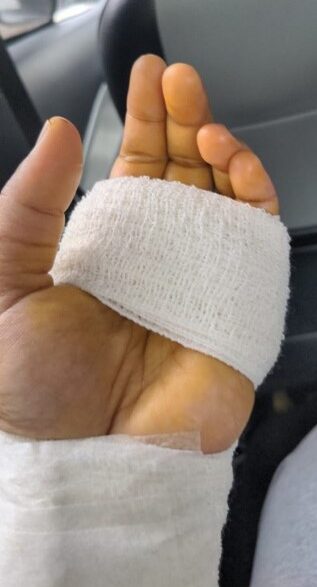Deep Laceration from knife while cutting avocado
Most of the time when we cut fruits, it is often eventful. Unfortunately, when we are not careful, especially when we are cutting hard fruits there can be incidents where penetrative trauma can incur to the hand.
In this patient, she was using a sharp knife to cut an avocado fruit. There was a certain amount of resistance encountered when she was cutting the fruit in her hand, and it resulted in an acute penetrative trauma from the tip of the knife. It entered into the volar (front) surface of the palm and exited in the dorsal (behind) region of her hand.
Following this injury, she had severe bleeding and numbness in the ring finger. She also had a deformity in the hand following this injury, and this was most probably from ligaments that were cut. She initially presented with the Accident and Emergency Department (A&E) and was told that there was a simple laceration that would need wound cleaning and closure. Having much apprehension, she consulted Dr Sathappan for a second opinion.

When she presented at the A&E, under Dr Sathappan’s review, she had severe worsening pain, limitation in movement, and numbness of the ring finger.
When such injuries are seen, it is imperative that a thorough assessment of the neurovascular status must be done. Moreover, to prevent infection, early intervention with antibiotics, tetanus toxoid administration as well as surgical intervention timed early is important.
The clinical assessment of the hand was consistent with the following findings which were resultant from the penetrative trauma:
- complex deep wound injury to the palm, exiting from the dorsum of the hand
- complete laceration of the digital nerve to the radial side of the ring finger, which needed exploration
- probable laceration of the digital artery in view of the proximity of penetrative trauma which explains the severe bleeding that the patient encountered initially
- probable laceration of soft tissue structures such as the capsules and muscles in the hand resulting in abnormal deformity in the hand

In view of the severity of the hand injury, it is important to do early wound cleaning and exploration. Moreover, delayed treatments can result in ascending infections that can affect the rest of the structures in the hand and in late cases, can even compromise full functioning of the hand. In view of this, she was immediately advised for surgical intervention.
She was started on intravenous antibiotics and underwent surgery within a few hours following her admission. At surgical intervention and as per the clinical photographs, she was noticed to have lacerations to the following structures:
- digital nerve to the ring finger
- common digital artery to the third web space
- capsule of the metacarpal phalangeal joint (supportive structure around finger joints)
- interossei hand muscle (small muscles in the hand)
- torn lumbrical muscle (small muscles in the hand)
She had aggressive wound cleansing and debridement. Following this, utilization of microscope was done to do digital nerve and artery repair. Following this surgical repair, she had also a repair of the lacerated muscles and capsules. It is important to do immediate irrigation of the joint to prevent septic arthritis of the hand. She was kept inpatient for two days to administer intravenous antibiotics to prevent infection.

Following optimal recovery of her wound, she was discharged with outpatient review.
At clinical reviews, due to optimal wound management, she was noted to have good healing of the skin and functional recovery was also noted to be improving at subsequent reviews.

It is important in hand injuries for early intervention with surgical and postoperative management together with functional rehabilitation using hand therapy. The patient had intensive hand therapy exercises which permitted her in regaining back her full normal hand function as depicted in the video.
Moreover, the nerve injury that she incurred was repaired early. This resulted in improved nerve function. At the latest review, she was noted to have an advancing Tinel. Tinel is a sensory test assessment of the nerves. When a gentle tap is applied to the overlying nerve, the patient will often describe a sensory tingling sensation. In this patient, the initial Tinel was noted at the area of the laceration which was at the webspace and palm region. Over a recovery of 5 months, she was noted to have an advancing Tinel which is now ending at the fingertip. This is very optimal suggestion for good recovery of nerve function. Most nerves will improve over a period of 6 months to 2 years, depending on the severity of the nerve injury. If the nerve was not repaired, she will have permanent numbness in the finger. Numbness of the finger will significantly affect the function of the hand.
At this juncture, the patient has already returned back to her active job in computing line which involves typing as well as being able to perform all housework activities. She has no limitations in functions of activities. The video clip also demonstrates the good finger and grip movement of the patient.
Share this blog via:





